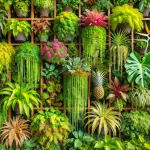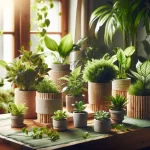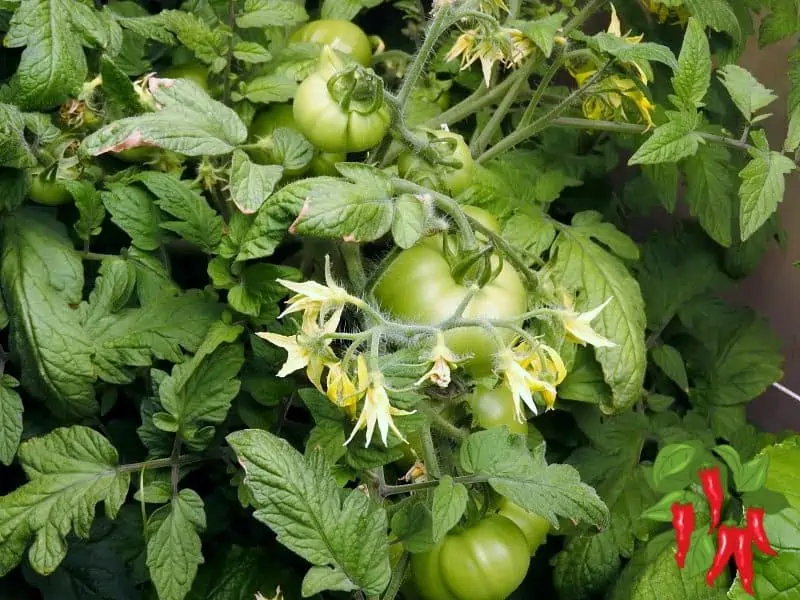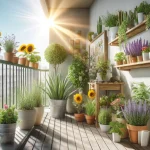This post may contain affiliate links. If you buy something from one of our links we may earn a commission. Thanks

From Discus to Paludarium: Transforming My 90-Gallon Tank Into a New Adventure
🌊 Have you ever had to make a tough call in your fishkeeping journey? 🐟 I sure did.
After my 37-gallon tank sprang a leak, I had to quickly move my discus into a 90-gallon tank.
At first, it felt like an upgrade, but then reality hit me. Glass tanks don’t last forever, and old seams can fail after 10–15 years.
Facing the risk of 90 gallons bursting in a second-floor apartment, I had no choice but to rehome my beloved discus. It wasn’t easy, but it opened the door to a brand-new adventure.
What Is a Paludarium?
- A hybrid setup combining land and water in one tank
- Allows both aquatic and terrestrial plants to thrive together
- Perfect for creating a mini indoor jungle 🌿💧
- Lower water levels reduce tank pressure and extend lifespan
- Great for incorporating waterfalls, vines, and humidity-loving plants
🐟 Saying Goodbye to My Discus
Discus often get a reputation for being “expert only,” but in my experience, they’re not as difficult as people say.
If you keep the water warm, clean, and stable, these fish really do thrive. A simple routine of good filtration and a 25% water change every week kept mine healthy and happy.
That’s why parting with them wasn’t easy. I loved watching their peaceful nature and vibrant colors and it made the tank feel alive.
But after realizing the risks of keeping such a large, aging aquarium, I knew I couldn’t take the chance in an upstairs apartment. I listed them on Craigslist and was lucky to find a local buyer who appreciated discus as much as I do.
Letting them go felt like losing a little piece of my aquarium journey, but knowing they were headed to a good home made the decision bearable.
Sometimes in this hobby, the hardest choices end up being the right ones.
🏚️ The Risk of Old Aquariums
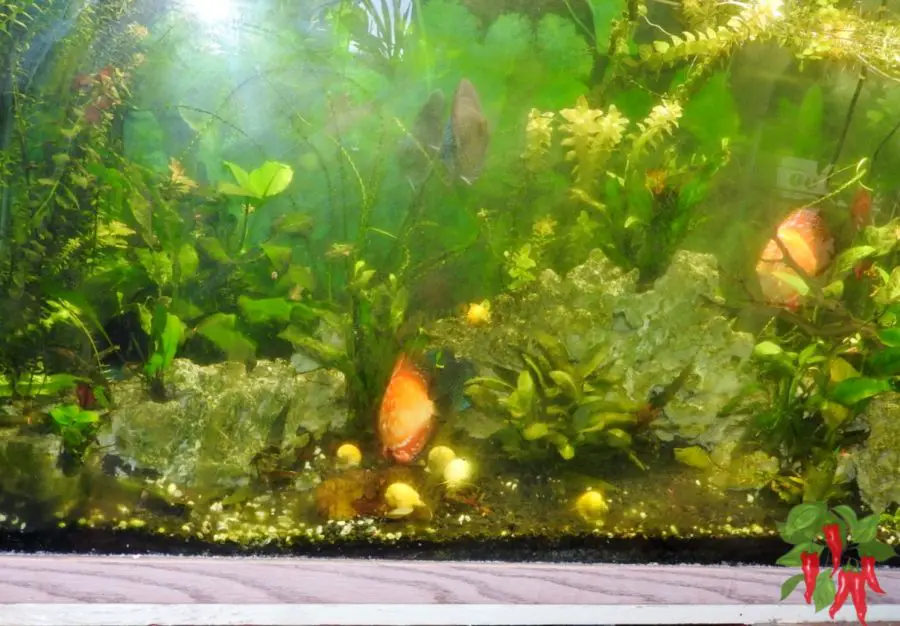
When I first got into fishkeeping, I thought a glass tank would last forever as long as you kept it level and didn’t mess with the seams.
Turns out, that’s not the case. Most glass aquariums have a lifespan of about 10–15 years before the silicone starts to break down.
My 90-gallon tank was already showing its age with worn seams and that old-school wood grain trim.
I bought this tank used, and later noticed some seams had been patched on the bottom. So I was nervous about this older tank.
After my 37-gallon leaked, the thought of 90 gallons of water pouring into a second-floor apartment was enough to keep me up at night. That much water could cause serious damage in minutes.
The good news? By draining the tank down and keeping just 5–6 inches of water, the pressure on those seams drops dramatically.
Instead of straining against the full weight of 90 gallons, the glass only has to hold a shallow pool—making the setup far safer and giving me peace of mind.
🌱 The New Plan: Building a Paludarium
Instead of giving up on the tank altogether, I decided to take it in a new direction—a paludarium.
If you’re not familiar, a paludarium is part aquarium, part terrarium: half water and half land.
It blends aquatic plants and creatures with lush terrestrial greenery, creating a little slice of jungle right in your home.
My 90-gallon happens to be perfect for this. It’s the same footprint as a 75-gallon but taller, which means I can take advantage of the vertical space.
That extra height opens the door to waterfalls, vines trailing up and out of the tank, and room for larger tropical plants.
On top of that, lowering the water level eases the strain on the aging seams—so not only will the tank last longer, but I’ll have way more freedom to get creative with the design.
I can already picture the sound of trickling water, lush green leaves climbing upward, and a true indoor jungle vibe. 🌿💦
🌿 Plant Possibilities for a Paludarium
One of the coolest things about a paludarium is mixing aquatic plants with houseplants that love humidity.
Many of the aquarium plants I already have can grow “emersed,” meaning their roots stay in water while their leaves rise above the surface. Cryptocorynes and anubias are great examples that adapt well to this setup.
On the land side, I can finally bring in some tropical favorites. Peace lilies, anthuriums, and Chinese evergreens all thrive in moist, humid conditions. Philodendrons and pothos can also work beautifully.
Together, these plants can create a layered, jungle-style backdrop full of texture and color.
And let’s not forget the critters already in the tank. My mystery snails will happily keep gliding through the shallow water, helping with algae control and adding life to the aquatic side of the setup.
I also spotted some laser cory catfish and Japanese trapdoor snails from older tank builds.
A paludarium isn’t just about plants—it’s about building a small ecosystem where water and land blend naturally.
🔧 Equipment & Setup Ideas
Since I’ll only be keeping 5–6 inches of water in the tank, the setup will be much simpler than a full aquarium.
A couple of sponge filters, airstones, or small pumps will be enough to keep the water circulating and oxygenated. The key will be tucking them away so the hardware doesn’t distract from the natural look.
I’m also toying with the idea of adding a small waterfall or trickle feature. With the extra height in this tank, I could easily build a raised section of land where water cascades back down into the shallow pool.
Not only would that boost humidity for the plants, but it would also give the whole setup that soothing jungle sound. 🌊🌿
By keeping the equipment minimal and discreet, I can focus on letting the plants and design shine while still maintaining a healthy environment for anything living in the water.
❓Frequently Asked Questions
Are discus really hard to care for?
Not as much as their reputation suggests. As long as you keep their water warm, clean, and stable, discus can thrive with weekly 25% water changes and good filtration.
How long does a glass aquarium last?
Most glass aquariums have a lifespan of 10–15 years before the silicone seams begin to weaken. After that, they may need to be resealed to avoid leaks.
What is a paludarium?
A paludarium is a hybrid setup that combines land and water in the same tank. It allows you to grow both aquatic and terrestrial plants together, creating a lush, natural environment.
What plants work well in a paludarium?
Many aquarium plants like cryptocorynes and anubias can grow emersed. You can also add tropical houseplants that love humidity, such as peace lilies, anthuriums, Chinese evergreens, and philodendrons.
Do paludariums need special equipment?
Not necessarily. A shallow water level with a sponge filter or small pump for circulation is often enough. You can also add waterfalls or trickle features for aesthetics and humidity.
💭 Looking Forward
Letting go of my discus was tough, but instead of focusing on the loss, I’m choosing to see this as a chance to start fresh. What began as disappointment is already turning into an exciting new project.
A paludarium opens the door to so much creativity—layering plants, designing land and water features, and even experimenting with waterfalls or vines that grow right out of the tank. It’s part gardening, part aquascaping, and part indoor jungle design. 🌿💧
I’ll be sharing future updates and videos as this build comes together, and I’m looking forward to watching it evolve.
If you’re in a position to keep discus, I absolutely recommend them—they’re beautiful, peaceful fish and not nearly as tricky as their reputation suggests.
But if life throws you a curveball like it did me, don’t be afraid to try something new. You might just end up with a setup that inspires you in unexpected ways.
Key Takeaway 🌟
Sometimes change isn’t the end—it’s the start of something even more exciting. My discus chapter is closing, but the paludarium adventure is just beginning.
Read more: Planted Aquariums: A Beginner’s Guide to Success
Visit my Amazon Influencer Page for videos and gardening products Grow Your Own Garden

